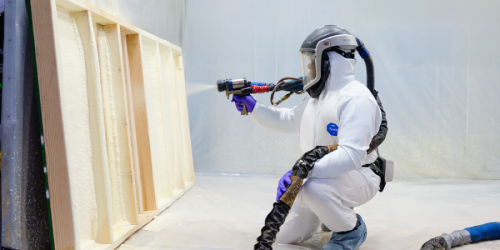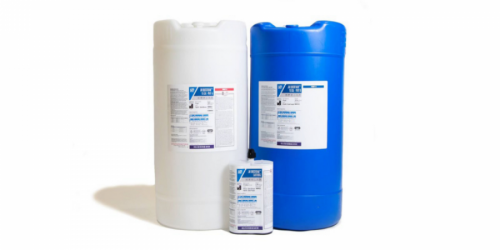Q&A Forums
Acrylic versus Silicon Post New Topic | Post Reply
| Author | Comments |
|---|---|
|
George Phelps
Posted: Jul 07, 2008 09:44 PM
|
Acrylic versus Silicon
Currently I have acrylic top coat on a Miami roof. It performed poorly lasting barely 2 years before showing wear. So I'm thinking about adding more coats of the same acrylic at $98 per 5 gallons. But...Lanco has an acrylic silicon blend at $46 for 5 gallons. A good savings. Are there any down sides if I use the Lanco with silicon? If I want to add more foam will there be an adhesion problem? |
|
mason
Posted: Jul 07, 2008 11:08 PM
|
elastomeric coatings should be made specifically for SPF roofing. You cannot get the right kind of performance from a Home Depot type product. A good acrylic coating will last 10 to 15 years before a recoat is neccesary. You should install around 3.5 gallons per square in 2 coats to achieve around a 25 dry mil average application. (55 to 60 percent solids by volume). Check out my articles on SPF roofing on my website, masonknowles.com |
|
mason
Posted: Jul 07, 2008 11:11 PM
|
I am not familiar with the brand Lanco. But silicone coatings can typically be installed over acrylic but not the other way around. But I am not familiar with a siliconized acrylic coating that is specifically designed for SPF. |
|
mason
Posted: Jul 07, 2008 11:17 PM
|
I checked on the Lanco coating. Their silconized acyrlic has a solids content of only 40 percent. So you would need 3 coats at 1.5 gal per square to achieve 25 dry mils of coating. Also,it is not one of the traditional brands used over the years in the industry. So, I do not have any field performance history to relate on the coating. |
|
George Phelps
Posted: Jul 08, 2008 10:16 AM
|
Thanks Mason. Next thing I do is to check out your website. |
|
George Phelps
Posted: Jul 08, 2008 11:21 AM
|
Mason, Your website was a good read. I Googled Lanco and found that they are in Miami with their factory in Orlando. I called their tech support and spoke with Victor at 866-447-2400 and found him to be knowledgeable. I had been thinking to use Lanco RC 100. Victor pointed me towards Ultra Silconizer as the best product for SPF. This product has 60% solids by weight and 46% by volumn. Here is the link: http://www.lancopaints.com/english/products/Technical%20Data%20Sheet/4-Roof/3-Elastomeric%20Latex%20Coating/TDRC905EN.pdf This product will require 2 coats at about 75 sq.ft. per gallon. That translates to about 30 5/gallon buckets at $108 per 5 gallons or $3,250.00. Pallet price might save me a few hundred dollars. Is there another brand that might do a better job for less? |
|
George Phelps
Posted: Jul 08, 2008 11:55 AM
|
Getting interesting. Just spoke with the distributor and did get a better pallet price. I discovered another Lanco product called Urethanizer. Costs more because of it's ceramic bead technology. I guess this is the best product. So I'm thinking 1st caot Ultra Silconizer followed by a second coat of Urethanizer. What do you think? |
|
mason
Posted: Jul 08, 2008 01:54 PM
|
George, You can ignore the solids by weight and go by solids by volume. The greater the solids by volume content the better coverage you will achieve. Also, assume at least a 20% waste even with a smooth surface, with a rougher surface assume 30-40% waste. So a 40% material would only provide 6.4 dry mils per 100 sq ft per gallon. Add you waste factor of 25% and you only have around 5 mils per 100 sq ft per gallon. Even at 2 applications of 1.5 gal/sq you would only have around 15 dry mils. Most coatings used over foam have between 55 to 60% solids content which would provide a theoretical yield of 8.8 to 9.6 dry mils per gallon per square (100 sq ft). So even with a 20% waste factor you could count on getting 25 to 30 dry mils with two coats of 1.5 gal/sq There are many coating suppliers that have track records on sprayfoam roofing going back 30 even 40 years. Check out sprayfoammagazine.com under the Buyers Guide for coating suppliers also, check out sprayfoam.org. I am familiar with at least 2 dozen coating manufacturers whose products have been proven over the years. One way to tell is if they have FM Class I Roof Covering Approvals or at the minimum UL 790 Class A ratings. The better rating is the FM because it tests for hail resistance, wind and fire resistance, whereas the UL 790 just tests for fire. PS. Building codes require either a UL 790 Class A, B or C rated roof covering (foam and coating tested together) or a FM Class I Roof Covering Approval. Hope this helps. |
|
George Phelps
Posted: Jul 08, 2008 02:47 PM
|
That was exactly the info I needed. Thanks! Let me get busy looking... |
|
George Phelps
Posted: Jul 14, 2008 10:35 PM
|
Mason, So I am probably not going to use any more SPF. Instead I'm tending towards Gaco 100% silicon and adding #10 or #11 granules. Or their U^^ urethane with Gacoshells. Either process will fill in the ponds and level out the uneven parts of the SPF roof. Then top coat the roof with S-1000 or S-2000. The only concern is the cost of the silicone. So another option is to use the Lanco Ultra Silconizer. This would cut my costs by about $150.00 per 5 gallons...and I need about 27 such buckets. Any thoughts? |
|
mason
Posted: Jul 15, 2008 11:15 AM
|
Doesn't sound like a good plan to me. Most coatings are not designed to be used as fill and will not provide adequate dimensionall stability. (at thicker applications will shrink and crack). Remove the coating in the ponds and spray more foam or cut grooves and channels. That is the best way to provide positive drainage. |
|
George Phelps
Posted: Jul 20, 2008 01:45 PM
|
Hi Mason, I have met with many SPF'ers and this past met with Gaco rep. I am really tending towards the silicone with filler. Done in numerous pours I'm fairly convinced it'll work fine. After researching walnut shell for grit and filler I stumbled across rubber crumb at: http://www.tirerecyclingcrumbrubbershredder.com/contact.php Here is my question to the rubber crumb folks: "I have a spray foam roof which I intend to thick coat with silicone paint. Roofers tend to incorporate walnut shell into acrylic or silicone top coat for traction. My problem is I want to use silicone plus a filler to level off an uneven roof and to create pitch. Do you think rubber crumb would make an appropriate filler? If so what size do you recommend?" Silca or sand tend to work loose from silicone. Walnut shell is small. Rubber crumb cam be larger in volumn so it'll fill in the space faster and I believe it'll bond better with silicone. Also the price is 17 cents per pound...with a 250 pound minimum order. |
|
George Phelps
Posted: Jul 20, 2008 02:08 PM
|
Just found that crumb rubber is used in roofing. http://www.wipo.int/pctdb/en/wo.jsp?wo=2000005314&IA=CA1999000670&DISPLAY=DESC |
|
mason
Posted: Jul 21, 2008 08:09 AM
|
George, Anytime you add a filler to a coating, it will change its physical properties and perhaps its performance. Why try to invent the wheel? You take on the liability of a manufacturer when you add something to the product. Installing granules or walnut shells to the top coat is very different from mixing a filler into a coating. Most coatings are not designed to be installed at greater thickness than 15 to 25 dry mils per application and typically no more than 45 to 60 dry mil total. You would have to install 3-5 inches of coating to get a positive drainage. Coatings are not made to do this, adding fillers to accomplish this will most likely spread the resins of the coating far apart so they do not have the neccessary tensile strength and UV resisttance. My original recommendation stands, take off the coating in the low areas, spray more foam, cut channels in the foam to enhance drainage. |
|
George Phelps
Posted: Jul 21, 2008 09:20 AM
|
I bet you're right! You are the knowledgeable one here but this is what has me thinking about alternatives. http://www.wipo.int/pctdb/en/wo.jsp?wo=2000005314&IA=CA1999000670&DISPLAY=DESC Here are abbreviated excerpts from the above credited website: "The composition can be used in various ways including as an architectural coating (ie. internal or external stucco, stipple or roof coating or patching), as an acoustic coating for sound proofing or damping. The coating can be applied in any desired way such as by spraying, trowelling, paint rolling or brushing. The coating will adhere to most structural surfaces and can be applied directly on concrete, wood, drywall, plastic, previously painted surfaces, metal, fibreglass and cement (i. e. cementitious base coats). The coating can achieve a variety of finished appearances ranging from a smooth finish to a rough "California stucco"appearance as determined by crumb rubber size used and the method of application. The coating can be used as a base coat or as a finish coat. In some applications, it may be desirable to include other components to the composition. For example, the coating composition including silicone resin and crumb rubber will be very slippery when water is applied thereto. Thus, to reduce the slip properties of the composition and/or to enhance the abrasion resistance or other properties, a grit material such as, for example, sand, perlite or fumed silica can be added. The grit material is generally less than 10% by volume of the coating composition." Anyway I used Lanco Ultra Silconizer on the pitched part yesterday. Nice! Goes down blue and turns white overnight...good for seeing missed spots. Did a small Lanco pour about 1/4 inch thick in some low undulated areas. Still hasn't cured. Hopefully the sun will cook the moisture out of it a bit. Going to Home Depot to get more Lanco and see if they have pearlite or something similar. |
|
mason
Posted: Jul 21, 2008 02:35 PM
|
George, I worked for a coatings company some years ago that made a coating with the tire regrind material. We thought it had great potential just and after a years worth of field tests started selling it in a localized area over metal roofs. Well, within a few years the coating started to go bad, cracking, loss of adhesion, poor UV resistance etc. Now we thought we knew what we were doing and still came up with a cruddy material. Chances are good that you would not get it right working on your own. This requires very knowledgeable coating chemists with loads of experience to design. |





























